AMD FX-8370E CPU Review: Vishera Down to 95W, Price Cuts for FX
by Ian Cutress on September 2, 2014 8:00 AM ESTGaming Benchmarks
F1 2013
First up is F1 2013 by Codemasters. I am a big Formula 1 fan in my spare time, and nothing makes me happier than carving up the field in a Caterham, waving to the Red Bulls as I drive by (because I play on easy and take shortcuts). F1 2013 uses the EGO Engine, and like other Codemasters games ends up being very playable on old hardware quite easily. In order to beef up the benchmark a bit, we devised the following scenario for the benchmark mode: one lap of Spa-Francorchamps in the heavy wet, the benchmark follows Jenson Button in the McLaren who starts on the grid in 22nd place, with the field made up of 11 Williams cars, 5 Marussia and 5 Caterham in that order. This puts emphasis on the CPU to handle the AI in the wet, and allows for a good amount of overtaking during the automated benchmark. We test at 1920x1080 on Ultra graphical settings.
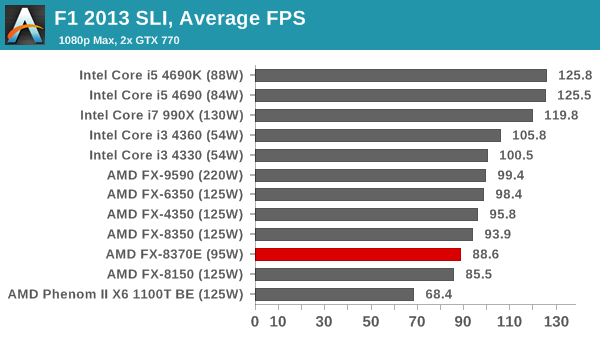
In all combinations, the 8370E and the 8150 duke it out. F1 2013 seems to be an Intel dominated title, given the i3 and outperform the FX-9590.
Bioshock Infinite
Bioshock Infinite was Zero Punctuation’s Game of the Year for 2013, uses the Unreal Engine 3, and is designed to scale with both cores and graphical prowess. We test the benchmark using the Adrenaline benchmark tool and the Xtreme (1920x1080, Maximum) performance setting, noting down the average frame rates and the minimum frame rates.
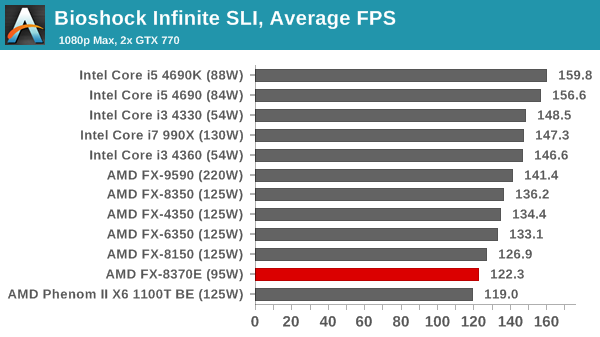
The FX-8350 again fits in just beneath the FX-8150, but for a lower power consumption.
Tomb Raider
The next benchmark in our test is Tomb Raider. Tomb Raider is an AMD optimized game, lauded for its use of TressFX creating dynamic hair to increase the immersion in game. Tomb Raider uses a modified version of the Crystal Engine, and enjoys raw horsepower. We test the benchmark using the Adrenaline benchmark tool and the Xtreme (1920x1080, Maximum) performance setting, noting down the average frame rates and the minimum frame rates.
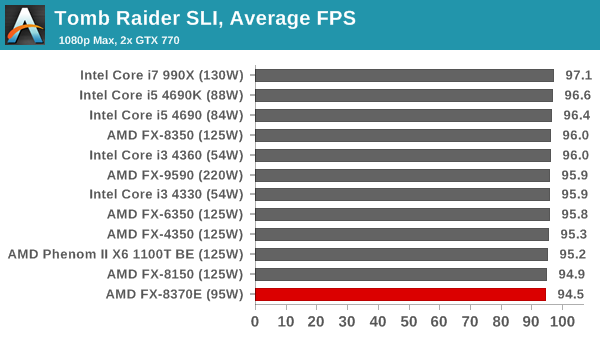
Tomb Raider continues to be CPU agnostic, even around the FX quad thread CPUs.
Sleeping Dogs
Sleeping Dogs is a benchmarking wet dream – a highly complex benchmark that can bring the toughest setup and high resolutions down into single figures. Having an extreme SSAO setting can do that, but at the right settings Sleeping Dogs is highly playable and enjoyable. We run the basic benchmark program laid out in the Adrenaline benchmark tool, and the Xtreme (1920x1080, Maximum) performance setting, noting down the average frame rates and the minimum frame rates.
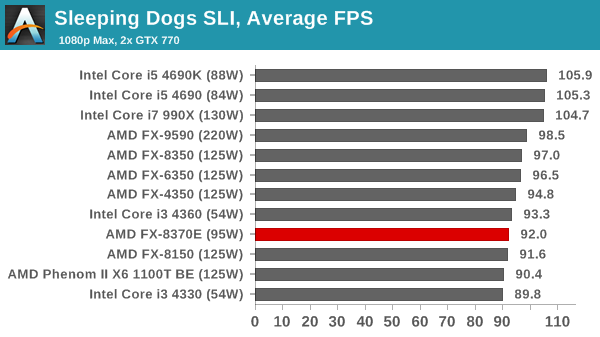
The eight threads offers some advantage in minimum frame rates, but average frame rates are still around the FX-8150.
Battlefield 4
The EA/DICE series that has taken countless hours of my life away is back for another iteration, using the Frostbite 3 engine. AMD is also piling its resources into BF4 with the new Mantle API for developers, designed to cut the time required for the CPU to dispatch commands to the graphical sub-system. For our test we use the in-game benchmarking tools and record the frame time for the first ~70 seconds of the Tashgar single player mission, which is an on-rails generation of and rendering of objects and textures. We test at 1920x1080 at Ultra settings.
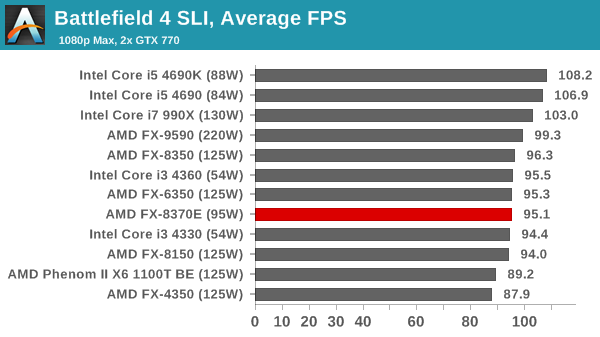
The FX-8370E stretches its legs a little in terms of minimum frame rates, particularly in SLI, however it is handily beaten by the i3-4330.















107 Comments
View All Comments
just4U - Tuesday, September 2, 2014 - link
I noticed with cpu-z that power is all over the place. so yeah.. but still..Death666Angel - Tuesday, September 2, 2014 - link
"e.g., my 4790K at 4.4 GHz on all the cores at 1.225 V consumes around 115 W"So you are running the CPU out of spec but expect it to be in spec in other areas? If you OC, you increase the TDP! Don't OC and it will stay very much within its TDP limit.
just4U - Tuesday, September 2, 2014 - link
4.4GHZ is turbo boost on the 4790K. It runs at that speed out of the box.
Akrovah - Tuesday, September 2, 2014 - link
Only on a single core. He specified 4.4 Ghz on all cores. hence the assumption of overclocking.TiGr1982 - Tuesday, September 2, 2014 - link
The Turbo for all the cores loaded is officially 4.2 for 4790K. However, even at 4.2 it won't stay in its 88 W, unless you are lucky to get a very good CPU instance in order to undervolt it enough and still maintain stability - just look all the reviews of 4790K - it consumes quite a bit more power than 4770(K) under heavy CPU load, despite the formal 4 W (88 W vs 84 W) TDP difference. I haven't finished my tuning yet, but anyway, obviously, going from 4.2 to 4.4 at the same voltage won't increase TDP from 88 W to 115 W.Flunk - Tuesday, September 2, 2014 - link
Thermal Design Power is the amount of power that the chip is supposed to generate, not power used. Also, how are measuring power consumption? There are a lot of factors involved and its difficult to isolate just the CPU.techguyz - Thursday, September 4, 2014 - link
And do you think a 95w AMD CPU uses just 95w? Nope.TiGr1982 - Tuesday, September 2, 2014 - link
No, these Piledriver-based FXes are just 2 years old, not 3 :)These were first released back in October 2012.
silverblue - Tuesday, September 2, 2014 - link
They're Bulldozer done better, though not quite right, so you can perhaps forgive the "3 years old now" comment; still, I'd really like to see detailed power consumption figures especially when compared to the FX-8150, just to see how far they've actually come in that area.TiGr1982 - Tuesday, September 2, 2014 - link
Yes, if you add up initial Bulldozer FX-8150, OR-B2 ("Orochi B2") and the likes, then it happens to be 3 years, I agree, because these Piledriver FXes are just OR-C0 ("Orochi C0)".